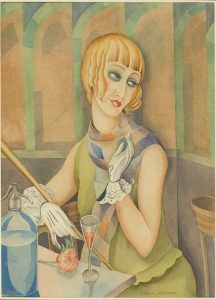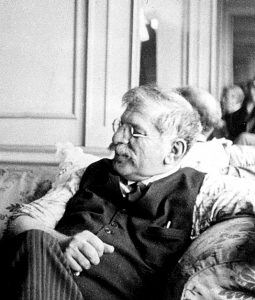The Queer Collections Project (QCP) began with seed funding from the Jane Rule Endowment for the Study of Human Relationships, with the goal of making significant additions to the UBC Library’s collections, thereby putting in place primary resources for undergraduate and graduate research into the study of sexuality. The QCP has received generous funding from the Jane Rule Endowment, UBC Library, the UBC Provost’s Office, and the Ulrich Maché Memorial Fund.

‘Portrait of Lili Elbe. Watercolour, c. 1928’ by Gerda Wegener.
This watercolour depicts the artist Lili Elbe, born Einar Wegener, who lived most of her life as a man. In 1930 she travelled to the Institute of Sexology in Berlin to undergo the world’s first sex reassignment surgery, supervised by Magnus Hirschfeld. The portrait is attributed to Elbe’s wife, the Danish artist Gerda Wegener. Following Elbe’s sex change their marriage was annulled as the law failed to recognize the marriage of two women. Credit: Wellcome Collection. CC BY
Perhaps the most important lesson we have learned from Michel Foucault is that sexuality has a history, or indeed, histories. Those histories, moreover, have left substantial material traces. The first editions of Teleny (1893) and Des Grieux (1899) are superb examples, since they represent the first material iterations of male homoerotic writing in English. They were published at a time when the discursive construction homosexuality was just beginning to be understood in identitarian terms. Teleny is the first “gay” novel, and as such it represents the foundation of an entire literary genealogy. Thanks to coordinated efforts by faculty and UBC Library staff, we now have copies of these rare materials at UBC.
Another recent acquisition in this area is the anthology Homosexual Love in World Literature, originally published in 1900. This collection of poetry is considered to be the first anthology of “gay” or homoerotic poetry, presenting examples from a number of world literatures and cultures. Its editor, Elisarion von Kupffer, argued for an appreciation of different sexualities, not merely a toleration of them; with this collection, he hoped to contribute to greater understanding of cultural expression related to these diverse sexual feelings.
The materials we hope to acquire naturally go far beyond the gay male experience. Our goal is to ensure that the project’s acquisitions address wide arrays of experience, including early engagements with intersex and trans* histories. We propose to build on these foundations by inaugurating a new collecting mandate at RBSC in queer archival material, such as rare historical printed books, ephemera, letters, diaries, artwork and other historical documents.
The Queer Collections Project is, in short, a multidisciplinary endeavour. This partnership among various units benefits all parties involved as well. The Library, for its part, would be able further to expand its holdings in a new collecting area, and the JRE and CSIS would be working with the central research node on campus, thereby increasing the visibility and reach of sexuality studies at UBC.
When combined with classroom and research activities, these materials from the past will contribute to a more compassionate understanding of the present. In an article on the utility of archival research for student learning, Heidi McKee and James Porter (2012) refer to the “person-ness” of archives and archival materials. In their examination, they partly explore the important questions of “ownership” of history and vividness of human experience in past eras. We live in an increasingly digital age, one that is habitually removed from the tactile and sensory experience of working with printed materials held in an archive. Our project complements our students’ digital lives and draws on faculty expertise in order to add to students’ appreciation for the historical value of the materials in question. These questions are especially fraught when we consider the genealogy of questions of gender, sexuality, and queer experience. Archival objects testify to the historical, social, cultural, and legal development—both progression and regression—of queer reality and how individual embodiments of this reality have been expressed. The project aims, in short, to render visible and physical the reality of past queer individuals’ lives. The archival experience, comprising student and faculty collaboration, will, moreover, certainly complement the academic experience that many of our students have.

